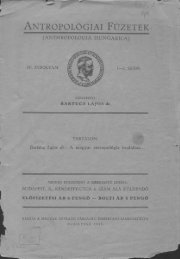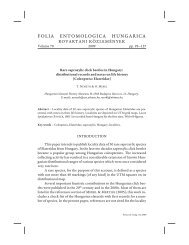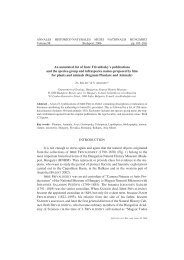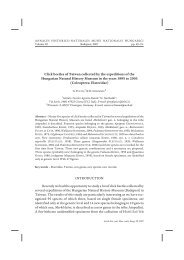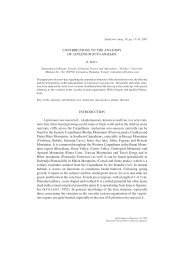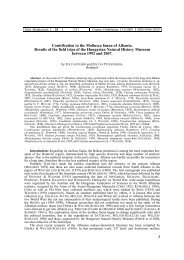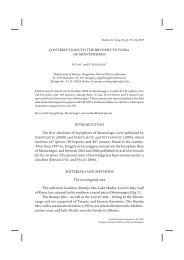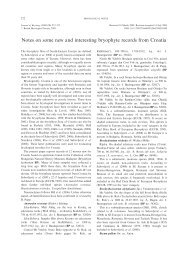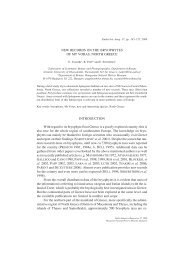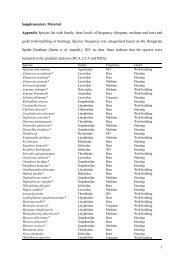phytosociological evaluation and multivariate analysis of the habitat ...
phytosociological evaluation and multivariate analysis of the habitat ...
phytosociological evaluation and multivariate analysis of the habitat ...
Create successful ePaper yourself
Turn your PDF publications into a flip-book with our unique Google optimized e-Paper software.
Studia bot. hung. 36, pp. 43–66, 2005PHYTOSOCIOLOGICAL EVALUATION ANDMULTIVARIATE ANALYSIS OF THE HABITAT OFLINUM DOLOMITICUM BORBÁS (LINACEAE) II *K. DOBOLYIDepartment <strong>of</strong> Botany, Hungarian Natural History MuseumH-1476 Budapest, Pf. 222, Hungary; dobolyi@bot.nhmus.huPhytosociological study <strong>of</strong> Linum dolomiticum <strong>habitat</strong> has been carried out based on 135 relevés on<strong>the</strong> complete area <strong>of</strong> distribution. The <strong>habitat</strong> encompasses <strong>the</strong> following plant communities: Seselileucospermi-Festucetum pallentis, Stipo eriocauli-Festucetum pallentis, Seseli leucospermi-Brometumpannonici, Festuco pallenti-Brometum pannonici <strong>and</strong> several transitions <strong>and</strong> degraded forms <strong>of</strong><strong>the</strong>se communities. These grassl<strong>and</strong>s in part belong to <strong>the</strong> herb layer <strong>of</strong> <strong>the</strong> Pannonian karst white oaklow woods. The vegetation was analysed statistically according to life form, phytogeographical area,<strong>phytosociological</strong> character, social behaviour type <strong>and</strong> ecological indicator values (preference categories)<strong>of</strong> <strong>the</strong> species. The <strong>habitat</strong> <strong>of</strong> Linum dolomiticum may be characterised by several types <strong>of</strong>coenotones <strong>and</strong> ecotones. With 17 tables <strong>and</strong> 2 figures.Key words: coenotone, dolomite rock grassl<strong>and</strong>s, ecotone, Linum dolomiticum, <strong>multivariate</strong> <strong>analysis</strong>,phytosociologyINTRODUCTIONPrevious <strong>phytosociological</strong> study <strong>of</strong> <strong>the</strong> <strong>habitat</strong> <strong>of</strong> <strong>the</strong> endemic Linum dolomiticumwas carried out by MÉSZÁROS-DRASKOVITS (1967), <strong>and</strong> <strong>multivariate</strong><strong>analysis</strong> <strong>of</strong> <strong>the</strong> original relevés was published in <strong>the</strong> first part <strong>of</strong> our study (DO-BOLYI 2003). As those investigations covered only a relatively small part <strong>of</strong> <strong>the</strong>full distribution area, <strong>the</strong>ir results are considered to be incomplete. As concludedby <strong>the</strong> earlier studies, <strong>the</strong> <strong>habitat</strong> <strong>of</strong> Linum dolomiticum belongs to <strong>the</strong> followingplant communities: Seseli leucospermi-Festucetum pallentis Zólyomi 1958, Stipoeriocauli-Festucetum pallentis Zólyomi 1966 <strong>and</strong> Seseli leucospermi-Brometumpannonici Borhidi 1996. However, more recent field experiences indicate thatLinum dolomiticum occurs in o<strong>the</strong>r forms <strong>of</strong> associations such as closed dolomiterock grassl<strong>and</strong>, degraded forms <strong>of</strong> rock steppes <strong>and</strong> karst white oak low woods(DOBOLYI 2001).Purpose <strong>of</strong> <strong>the</strong> recent study is to provide a <strong>phytosociological</strong> <strong>analysis</strong> for <strong>the</strong>complete distribution area <strong>of</strong> Linum dolomiticum, i. e. to determine <strong>and</strong> characteriseall vegetation types <strong>of</strong> <strong>the</strong> <strong>habitat</strong> <strong>of</strong> <strong>the</strong> species.* Dedicated to Rózsa Mészáros-DraskovitsStudia Botanica Hungarica 36, 2005Hungarian Natural History Museum, Budapest
44 DOBOLYI, K.The present study is based on 135 <strong>phytosociological</strong> relevés: 45 <strong>of</strong> <strong>the</strong>m weremade <strong>and</strong> published by MÉSZÁROS-DRASKOVITS (1967) <strong>and</strong> 90 new relevés madeby <strong>the</strong> author in <strong>the</strong> period <strong>of</strong> 2000–2003.MATERIAL AND METHODSNinety new <strong>phytosociological</strong> relevés <strong>of</strong> 2m×2msize were taken on <strong>the</strong> <strong>habitat</strong> <strong>of</strong> Linumdolomiticum so that <strong>the</strong> complete area <strong>of</strong> distribution <strong>and</strong> all types <strong>of</strong> vegetation be represented. Nomenclature<strong>of</strong> <strong>the</strong> plant names follows HORVÁTH et al. (1995). Cover values transformed to <strong>the</strong> scale1to9(VAN DER MAAREL 1979) <strong>and</strong> <strong>the</strong> additional data <strong>of</strong> <strong>the</strong> new relevés are shown in Tables 3 to 8.The <strong>multivariate</strong> data analyses <strong>and</strong> <strong>the</strong> <strong>phytosociological</strong> <strong>evaluation</strong> were based on both <strong>the</strong>new <strong>phytosociological</strong> relevés <strong>and</strong> <strong>the</strong> old ones taken by MÉSZÁROS-DRASKOVITS (1967) (135relevés altoge<strong>the</strong>r). The variables in <strong>the</strong> analyses were <strong>the</strong> transformed cover values <strong>of</strong> <strong>the</strong> species.Numbering <strong>of</strong> <strong>the</strong> relevés in <strong>the</strong> present study is given in Table 1.Five additional relevés were included in <strong>the</strong> <strong>multivariate</strong> analyses, which represent dolomitegrassl<strong>and</strong> communities marked by letters A to E (Table 2), which were compiled from <strong>the</strong> original descriptions(ZÓLYOMI 1958, BORHIDI 1996). These communities belong to <strong>the</strong> Bromo-Festucionpallentis Zólyomi 1966 alliance (BORHIDI 1996). These relevés served as reference in <strong>the</strong> comparisonsmade by classification <strong>and</strong> ordination methods indicating <strong>the</strong> place <strong>of</strong> <strong>the</strong> five relevant plantcommunities.Table 1. Numbering <strong>of</strong> <strong>the</strong> relevés in <strong>the</strong> <strong>multivariate</strong> data analyses <strong>and</strong> in <strong>the</strong> <strong>phytosociological</strong><strong>evaluation</strong>.Number <strong>of</strong> <strong>the</strong> relevés in <strong>the</strong> Origin <strong>of</strong> <strong>the</strong> relevés<strong>multivariate</strong> data analyses1–20 MÉSZÁROS-DRASKOVITS (1967), Table 1, 1–2021–45 MÉSZÁROS-DRASKOVITS (1967), Table 2, 1–2546–50 additional relevés (ZÓLYOMI 1958, BORHIDI 1996)51–140 new relevésTable 2. Plant communities represented by <strong>the</strong> additional relevés.Additional relevés Plant communityNumberMark46 A Seseli leucospermi-Festucetum pallentis Zólyomi 195847 B Stipo eriocauli-Festucetum pallentis Zólyomi 195848 C Chrysopogono-Caricetum humilis Zólyomi 195849 D Seseli leucospermi-Brometum pannonici Borhidi 199650 E Festuco pallenti-Brometum pannonici Zólyomi 1958Studia bot. hung. 36, 2005
PHYTOSOCIOLOGICAL EVALUATION OF THE LINUM DOLOMITICUM HABITAT 45The relevés were analysed by <strong>the</strong> following <strong>multivariate</strong> methods with SYN-TAX 2000 programpackages (PODANI 2001).1) hierarchical classifications– distance optimising procedure: group average (UPGMA)– global optimisation2) ordinations– centred principal component <strong>analysis</strong> (PCA)– principal coordinate <strong>analysis</strong> (metric multidimensional scaling; PCoA)The applied distance coefficients are Euclidean distance, Bray–Curtis-index <strong>and</strong> similarity ratio(PODANI 1997).The classifications <strong>and</strong> ordinations resulted in six groups <strong>of</strong> separated relevés. These groups<strong>and</strong> <strong>the</strong> mentioned five plant communities were submitted to <strong>multivariate</strong> analyses again in order todetermine <strong>the</strong> distances between <strong>the</strong> groups <strong>and</strong> <strong>the</strong> communities.The groups <strong>of</strong> relevés were analysed statistically on <strong>the</strong> basis <strong>of</strong> <strong>the</strong> following species characteristics:life form, phytogeographical area (floral element) (HORVÁTH et al. 1995), <strong>phytosociological</strong>character, social behaviour type <strong>and</strong> ecological indicator values (preference categories)(BORHIDI 1993). The values <strong>of</strong> features characterising <strong>the</strong> groups <strong>of</strong> relevés were calculated accordingto percentage pro rata <strong>of</strong> plant mass, that is, <strong>the</strong> sum <strong>of</strong> <strong>the</strong> transformed cover values concerningone feature has been expressed in percentage <strong>of</strong> sum <strong>of</strong> all cover values <strong>of</strong> all species.RESULTSThe results <strong>of</strong> <strong>multivariate</strong> analyses showed that six relatively homogeneousgroups <strong>of</strong> relevés may be separated (78 relevés altoge<strong>the</strong>r). The groups are characterisedwith <strong>the</strong> floristical composition <strong>and</strong> dominant species, distribution <strong>of</strong> lifeforms, phytogeographical <strong>and</strong> <strong>phytosociological</strong> spectrum, social behaviour type<strong>of</strong> <strong>the</strong> species <strong>and</strong> environmental <strong>and</strong> ecological circumstances. Results <strong>of</strong> <strong>the</strong> statisticalanalyses <strong>of</strong> <strong>the</strong> groups are in Tables 9 to 17. The groups represent <strong>the</strong> characteristicvegetation types <strong>of</strong> Linum dolomiticum <strong>habitat</strong>s. Some <strong>of</strong> <strong>the</strong>m can beidentified as belonging to <strong>the</strong> dolomite grassl<strong>and</strong> communities.Group IRelevés: 1-14, 60, 63, 102, 136.Characteristics <strong>of</strong> <strong>the</strong> group:– typical exposure: N, NW, W (Table 8),– low proportion <strong>of</strong> <strong>the</strong> total cover <strong>of</strong> vegetation,– relatively low number <strong>of</strong> species,– dominant species: Festuca pallens, Helian<strong>the</strong>mum canum, Thymus praecox,– highest proportion (22.7%) <strong>of</strong> Chamaephyta (Table 9),– highest proportion <strong>of</strong> Submediterranean <strong>and</strong> endemic species (Table 10),– <strong>phytosociological</strong> composition is similar to group II (Table 11),Studia bot. hung. 36, 2005
46 DOBOLYI, K.Table 3. Cover values <strong>of</strong> <strong>the</strong> species in <strong>the</strong> relevés <strong>of</strong> group II.No. <strong>of</strong> relevés67 71 72 73 75 77 79 81 83 84 88 97 98 99 101 109 125 133 134 135 137Alyssum tortuosum W. et K. – – 1 – – – – – – 1 1 – – – – – 1 – 2 1 2An<strong>the</strong>ricum ramosum L. 3 4 3 3 1 3 2 2 2 3 2 4 4 4 3 3 3 2 1 2 2Anthyllis vulneraria L. – 1 – – 1 – – – – – – – 1 2 – – – – – 1 1Asperula cynanchica L. – – 1 1 1 1 1 1 1 1 – – – – 1 1 1 1 1 1 –Aster linosyris (L.) Bernh. – – – 1 – – – – – – – – – – – – – – – – –Carex humilis Leyss. 4 4 4 4 5 4 4 4 3 4 3 3 4 5 3 3 4 4 3 2 4Carex liparicarpos Gaud. – 3 4 3 3 5 3 4 3 3 – 4 1 – 2 – – 1 – – 1Cuscuta epithymum (L.) Nath.subsp. kotschyi (Des Moul.) Arc. – – – – – – – – – – – – – – – – 1 – – – –Dianthus plumarius L. subsp.regis-stephani (Rapaics) Baksay – – – – – – – – – – – 2 – – – 2 – 1 2 1 2Draba lasiocarpa Roch. 1 – – – – – – – – – – 1 – – – 1 – 1 1 1 1Epipactis atrorubens (H<strong>of</strong>fm.) Bess. – – – – – – – – – – – 1 1 1 – – – – – – –Euphorbia cyparissias L. 1 – – – – – – – – – – – – – – – – – – – –Euphorbia seguieriana Necker – 1 2 1 2 – 1 1 – 1 – – – – – 2 3 2 2 2 1Festuca pallens Host 3 2 1 2 2 3 2 2 3 3 1 2 1 2 2 3 3 3 2 3 2Fraxinus ornus L. – – – – – – – – – – – – – – – 5 – – – – –Fumana procumbens (Dun.) Gren.et Godr. 2 2 3 2 1 2 – – – 1 3 1 2 2 2 3 – 2 1 2 2Galium verum L. – – – – – – – – – – – – 1 – – – – – – – –Genista pilosa L. – – – – – – – – – – – 1 1 – 2 – – – 1 – 1Globularia punctata Lap. 1 1 2 1 1 2 – – – – – 1 1 – 1 – – 1 2 1 1Gypsophila fastigiata L. subsp.arenaria (W. et K.) Dom. – – – – – – – – – – – – – – – 2 – 1 – 1 2Helian<strong>the</strong>mum canum (L.) Baumg. 3 5 4 4 4 4 4 4 4 4 5 5 5 5 3 4 4 4 4 3 3Inula ensifolia L. – – – 2 2 – – – – – – – – – – – – – – – –Jovibarba hirta agg. 2 – 1 – – 2 – 1 2 2 – 1 1 1 – 1 2 1 1 2 1Juniperus communis L. – – – – – – – – – – – – – – – 2 – – – – –Jurinea mollis (L.) Rchb. – 1 – 1 1 1 1 1 1 1 – – – – – 2 1 – 2 1 2Linum dolomiticum Borbás 4 4 3 5 5 5 4 3 3 3 4 4 3 4 4 4 4 4 4 3 4Linum tenuifolium L. 1 1 1 1 1 1 1 1 1 1 1 1 1 1 – 1 2 1 1 1 2Minuartia setacea (Thuill.) Hay. – – – – – – – – – – – – – – – 1 – – – – 2Studia bot. hung. 36, 2005
PHYTOSOCIOLOGICAL EVALUATION OF THE LINUM DOLOMITICUM HABITAT 47Table 3 (continued)No. <strong>of</strong> relevés67 71 72 73 75 77 79 81 83 84 88 97 98 99 101 109 125 133 134 135 137Onosma visianii Clem. – – – – – – – – – – – – – – – – – – – – 1Orthantha lutea (L.) Kern. 1 – 1 – – 1 1 1 – – – – – – – – 1 – 1 – –Paronychia cephalotes (M. B.) Bess. 1 – – – – – – – – – – – – – – – 3 – 2 2 3Peucedanum cervaria (L.) Lap. – 2 1 – – – – – – – – – – – – – – – – – –Peucedanum oreoselinum (L.) Mönch – – – – 2 – 2 1 – – – – – – – – – – – – –Poa badensis Haenke – – – – – – – – – – – – – – – – – – – – 1Polygonatum odoratum (Mill.) Druce – – – 2 2 2 – 3 2 – – 1 – – 2 – – – – 1 –Potentilla arenaria Borkh. – – 1 2 – 2 2 2 3 3 3 – – – 2 2 3 3 3 2 2Pulsatilla gr<strong>and</strong>is Wender. – – – 1 – – – – – – – – – – – – – 1 – – 1Sanguisorba minor Scop. – – – – – – 1 2 2 3 2 – – – – 1 3 2 2 2 2Scabiosa canescens W. et K. 1 – 2 2 2 2 1 1 1 2 – 1 1 2 1 – 2 2 1 2 1Scorzonera austriaca Willd. 1 – – – 1 – – – – – – – – – 1 – – 1 1 1 1Sedum album L. – – – – – – – – – – – – – – – – – – – – 1Seseli leucospermum W. et K. – 3 3 2 1 1 2 2 2 1 2 1 2 2 2 – 1 2 2 3 2Silene otites (L.) Wibel – – – – – – – – – – – – – – – – – – – – 1Stipa eriocaulis Borbás 3 – – – 3 – – – – – 2 1 2 3 2 1 3 3 1 2 4Teucrium montanum L. 3 2 1 2 2 2 1 3 3 – – – – – – 2 – 2 3 2 2Thalictrum minus L. subsp. pseudominus(Borbás) Soó – – – – – – – – – – – 3 2 2 – – – – – – –Thesium linophyllon L. – – – 1 – – – – – 2 – 2 1 – 1 – 1 – 1 – 1Thymus praecox Opiz 1 4 2 2 2 3 3 2 3 3 2 3 2 2 2 3 3 3 2 2 2Veronica spicata L. s. str. – – 1 – – – – – – 1 – – – – – – – – – – –Viola rupestris F. W. Schmidt – 1 1 1 – 1 1 – – – – 1 – – – 1 – 1 1 – –Studia bot. hung. 36, 2005
48 DOBOLYI, K.Table 4. Cover values <strong>of</strong> <strong>the</strong> species in <strong>the</strong> relevés <strong>of</strong> group V.No. <strong>of</strong> relevés89 90 92 93 94 95 126 127 128Allium montanum F. W. Schmidt – – – – – – 2 2 1An<strong>the</strong>ricum ramosum L. 6 6 5 5 5 6 4 4 4Anthyllis vulneraria L. 4 2 3 3 3 1 2 3 3Asperula cynanchica L. – 1 – – 1 1 – 1 1Berberis vulgaris L. – – 1 – – – – – –Biscutella laevigata L. – – – – – – – – 2Bromus pannonicus Kummer et Sendtner – 1 – – – – – 1 –Carex humilis Leyss. 6 6 6 6 6 6 7 6 7Carex liparicarpos Gaud. – 2 – – – – 1 – 1Chrysan<strong>the</strong>mum lanceolatum Pers. 2 2 3 3 4 1 3 3 2Coronilla vaginalis Lam. – – 4 – – – – – –Cuscuta epithymum (L.) Nath. subsp.kotschyi (Des Moul.) Arc. – – 1 – – – – – –Daphne cneorum L. – – – – – – – 1 –Dianthus plumarius L. subsp. regisstephani(Rapaics) Baksay – – – 1 – – – – –Epipactis atrorubens (H<strong>of</strong>fm.) Bess. – – – – – – – – 1Euphorbia seguieriana Necker – – – – – 1 – 2 –Fagus sylvatica L. – – – – – – – – 1Festuca pallens Host 4 2 3 2 1 – 3 3 3Fraxinus ornus L. 1 – 1 1 1 3 6 3 6Genista pilosa L. 4 5 4 5 5 6 4 3 3Gentiana cruciata L. – 1 – – – – – – –Globularia punctata Lap. – 3 – – 1 1 3 3 3Helian<strong>the</strong>mum canum (L.) Baumg. 4 3 4 5 4 3 4 4 4Helian<strong>the</strong>mum ovatum (Viv.) Dun. – – 2 – – – – – –Inula ensifolia L. 4 – – – 1 3 1 1 –Juniperus communis L. – – – – – 1 – 1 –Jurinea mollis (L.) Rchb. 1 2 3 2 1 2 2 3 1Linum dolomiticum Borbás 4 5 5 5 5 5 6 5 6Linum tenuifolium L. 1 1 2 – – – – 1 1Peucedanum oreoselinum (L.) Mönch – 4 – – – – 2 1 2Phyteuma orbiculare L. 4 4 5 5 4 3 2 3 4Polygala amara L. – 1 – – – – – – –Polygonatum odoratum (Mill.) Druce – – – – – – – 1 –Potentilla arenaria Borkh. – 2 – – – – – – 2Pulsatilla gr<strong>and</strong>is Wender. 1 – – – – – – – –Quercus pubescens Willd. 1 3 3 2 1 3 3 3 6Sanguisorba minor Scop. 1 2 3 1 – 1 1 2 –Scabiosa canescens W. et K. 3 – – 5 4 4 – – –Seseli leucospermum W. et K. 1 – – – – 1 1 1 1Stipa eriocaulis Borbás 1 – 1 – – 1 – – –Teucrium montanum L. 1 – – – 1 2 2 2 2Thalictrum minus L. subsp.pseudominus (Borbás) Soó – – 1 – – – – – –Studia bot. hung. 36, 2005
PHYTOSOCIOLOGICAL EVALUATION OF THE LINUM DOLOMITICUM HABITAT 49Table 4 (continued)No. <strong>of</strong> relevés89 90 92 93 94 95 126 127 128Thesium linophyllon L. 2 – 2 2 – 1 – – –Thymus praecox Opiz 1 – 2 – – 1 2 2 –Veronica spicata L. s. str. – 1 – – – – – – –Vincetoxicum hirundinaria Medik. – 1 – – – – – – –Viola rupestris F. W. Schmidt – – – – – 1 1 – –Table 5. Cover values <strong>of</strong> <strong>the</strong> species in <strong>the</strong> relevés <strong>of</strong> group VI.No. <strong>of</strong> relevés51 53 69 113 114 115 116 118 119 131Allium montanum F. W. Schmidt – – – 1 – – – – 1 1An<strong>the</strong>ricum ramosum L. 3 5 3 3 5 4 5 5 4 3Anthyllis vulneraria L. 3 4 1 1 2 2 3 – 2 2Asperula cynanchica L. – – 1 1 1 – 1 1 1 1Aster linosyris (L.) Bernh. – – – – 2 1 1 – – –Biscutella laevigata L. 1 1 1 – – 1 – 1 1 2Brachypodium pinnatum (L.) P. B. – – – – 1 – – – – –Bromus pannonicus Kummer et Sendtner 6 5 2 8 7 7 7 8 8 7Campanula rotundifolia agg. – 1 1 1 1 – 1 – – –Carex humilis Leyss. 6 5 7 3 6 5 5 6 6 5Chamaecytisus austriacus (L.) Link 2 – – – – – – – – –Chamaecytisus hirsutus (L.) Link – 2 – – – – – – – –Chrysan<strong>the</strong>mum lanceolatum Pers. 1 – 1 2 – – – 3 – –Cuscuta epithymum (L.) Nath. subsp.kotschyi (Des Moul.) Arc. – – 1 – 1 – 2 – – –Daphne cneorum L. 1 1 – – 2 – 1 – – 1Dorycnium germanicum (Gremli) Rikli – – 1 – – – – – – –Euphorbia cyparissias L. 1 – – – 1 – – – – –Festuca pallens Host – 1 1 2 – – – 1 1 1Festuca rupicola Heuff. 1 – – – 1 – – – – –Fraxinus ornus L. 3 3 5 3 4 4 4 2 3 2Genista pilosa L. 3 2 3 3 3 3 4 3 4 4Globularia punctata Lap. 1 1 1 – 3 2 – 2 2 2Helian<strong>the</strong>mum canum (L.) Baumg. 1 2 – 3 4 3 3 – 2 4Helian<strong>the</strong>mum ovatum (Viv.) Dun. – – 1 – – – – – 1 2Hieracium bauhinii Schult. (agg.) – – 3 – – – – – – –Inula ensifolia L. 6 6 – 3 – – – – – 1Inula hirta L. – – – 1 – – – 3 – –Juniperus communis L. – – – – 3 – – – – –Jurinea mollis (L.) Rchb. 2 – – 1 2 2 1 1 1 –Leontodon hispidus L. – – – – – – – 1 – –Linum dolomiticum Borbás 4 7 4 3 4 5 5 3 5 6Linum tenuifolium L. – – – 1 2 – – – – 1Peucedanum oreoselinum (L.) Mönch – – 4 – – – – – – –Studia bot. hung. 36, 2005
50 DOBOLYI, K.Table 5 (continued)No. <strong>of</strong> relevés51 53 69 113 114 115 116 118 119 131Phyteuma orbiculare L. 3 2 5 4 2 4 4 3 4 3Pinus nigra Arnold – – 5 – – – – – – –Polygala amara L. – 1 – – – – – – 1 1Polygonatum odoratum (Mill.) Druce – – 1 – – – – – – –Populus tremula L. – – 1 – – – – – – –Potentilla arenaria Borkh. – – – – 1 – – – 2 2Pulsatilla gr<strong>and</strong>is Wender. 1 3 – – – – – – – –Quercus pubescens Willd. 1 6 5 3 – 1 1 – 2 1Sanguisorba minor Scop. – – 1 1 3 2 2 1 2 –Scabiosa canescens W. et K. – 1 – 3 3 3 3 4 – 2Scorzonera austriaca Willd. – – – – 1 – – – – –Sorbus × semiincisa Borbás – – – 3 – – – – – –Stachys recta L. – – – – 1 – – – – –Stipa eriocaulis Borbás – – – – – – – – – 2Teucrium chamaedrys L. – – – – 3 – – – – –Teucrium montanum L. 1 1 – 2 1 3 1 2 3 2Thalictrum minus L.subsp. pseudominus (Borbás) Soó – – – – – – – – 2 3Thesium linophyllon L. 4 3 – 3 3 3 – 3 1 –Thymus praecox Opiz 1 – – – – – – 3 2 –Tilia cordata Mill. – – – – – – 2 – – –Vincetoxicum hirundinaria Medik. 1 – – 1 1 1 1 1 – –– highest proportion <strong>of</strong> Specialists <strong>and</strong> Unique specialists (43.5%) (Table 12),– highest proportion <strong>of</strong> <strong>the</strong> xero<strong>the</strong>rm species (Tables 13 <strong>and</strong> 14),– lowest nitrogen preference (Table 16),– highest continentality preference (Table 17).Vegetation type: seems to be <strong>of</strong> secondary origin from open dolomite rockgrassl<strong>and</strong>s deriving from several dolomite grassl<strong>and</strong> communities by degradation.The group falls close to Seseli leucospermi-Festucetum pallentis Zólyomi 1958 on<strong>the</strong> PCA diagram (Fig. 2).Group IIRelevés: 67, 71–73, 75, 77, 79, 81, 83–84, 88, 97–99, 101, 109, 125, 133–135,137 (Table 3).Characteristics <strong>of</strong> <strong>the</strong> group:– typical exposure: NW, W, SW (Table 8),– lowest proportion <strong>of</strong> <strong>the</strong> total cover <strong>of</strong> vegetation (average: 33.8%),Studia bot. hung. 36, 2005
PHYTOSOCIOLOGICAL EVALUATION OF THE LINUM DOLOMITICUM HABITAT 51Table 6. Cover values <strong>of</strong> <strong>the</strong> species in <strong>the</strong> remaining relevés.No. <strong>of</strong> relevés52 54 55 56 57 58 59 60 61 62 63 64 65 66 68 70 74 76 78 80 82 85 86 87 91Alyssum montanum L. – – – – – – – – – – – – 1 1 – – – – – – – – – – 1Alyssum tortuosum W. et K. – – – – – – – – – – 1 – – – 1 – – – – – – – – – –An<strong>the</strong>ricum ramosum L. 5 5 5 4 5 5 5 1 4 3 2 6 5 5 4 3 3 4 4 5 5 4 4 5 6Anthyllis vulneraria L. 3 3 3 1 1 2 1 – 1 1 – 1 – 1 – 1 1 2 – 1 – 1 1 4 2Asperula cynanchica L. 1 1 1 – – – – 1 1 1 1 – – – 1 – 1 1 1 1 1 1 1 – –Aster linosyris (L.) Bernh. – – 1 – 1 – – – – – 1 – – – – – – – – – – – – – –Berberis vulgaris L. – – – 1 – – – – – – – – – – – – – – – – – – – – 1Biscutella laevigata L. 1 1 1 1 – – – – – 1 – 1 – – – – – – – – – – – – –Briza media L. 1 – – – – – – – – – – – – – – – – – – – – – – – –Bromus pannonicus Kummer etSendtner 5 5 4 3 – 1 3 – – 5 – – – – – 2 – – – – – – – 4 –Campanula rotundifolia agg. – – 1 1 – – – – – – – – – – – – – – – – – – – – –Carex humilis Leyss. 5 – 6 6 5 6 6 3 7 8 2 6 6 5 4 7 5 5 5 5 3 7 4 6 6Carex liparicarpos Gaud. – – – 1 2 – – – – – 4 2 2 2 – – 3 4 4 5 3 2 4 – 2Chrysan<strong>the</strong>mum lanceolatum Pers. – – – – – – – – – 1 – – – – – 1 – – – – – – – – –Coronilla vaginalis Lam. – – – – – – – – – 2 – – – – – – – – – – – – – – –Dianthus plumarius L. subsp.regis-stephani (Rapaics) Baksay – – – – – – – – – – – – – – 1 1 – – 1 – 1 – – – –Dianthus pontederae Kern. – – – – – – – – – – – – 1 – – – – – – – – – – – –Dorycnium germanicum (Gremli) Rikli – – – – – – 1 – – – – – – – – – – – – – – – – – –Draba lasiocarpa Roch. – – – – – – – – – – – – 1 – – – – – – – – – – – –Euphorbia cyparissias L. – – – – 1 – – – 1 – – – 1 – – – – – – – – – – 1 –Euphorbia seguieriana Necker – – – – – – – – 1 – – – – – – 1 1 1 2 1 1 1 1 – –Festuca pallens Host 1 1 3 – 3 2 – 2 5 – 1 3 6 2 3 5 1 4 3 4 3 2 3 – 3Festuca rupicola Heuff. – – – – – 1 3 – – – – – – – – – – – – – – – – – –Fraxinus ornus L. 2 – 2 – 7 2 3 – 1 – – – – 2 1 2 – – – – – – – 4 8Fumana procumbens (Dun.) Gren.et Godr. – – – 1 1 – – 1 – – 2 1 – 2 2 – 3 2 3 2 2 – 2 – 1Galium verum L. – – – – – – – – – – – – 1 – – – – – – – – – – – –Genista pilosa L. 1 1 2 2 2 1 3 – – 2 – 2 – – – 2 – – – – – – – 6 2Globularia punctata Lap. 1 1 1 2 1 2 1 – 2 – – 1 – 2 – 2 2 1 3 2 – 3 2 – 3Gypsophila fastigiata L. subsp.arenaria (W. et K.) Dom. – – – – – – – – – – – – 1 – – 1 – – – – – – – – –Studia bot. hung. 36, 2005
PHYTOSOCIOLOGICAL EVALUATION OF THE LINUM DOLOMITICUM HABITAT 53Table 7. Cover values <strong>of</strong> <strong>the</strong> species in <strong>the</strong> remaining relevés.No. <strong>of</strong> relevés96 100 102 103 104 105 106 107 108 110 111 112 117 120 121 122 123 124 129 130 132 136 138 139 140Allium montanum F. W. Schmidt – – – – – – – – – 1 3 – – – – 1 – 2 – 2 2 – – – –Alyssum montanum L. – – – – – – – 1 – – – – – – – – – – – – – – 1 2 1Alyssum tortuosum W. et K. – – – 1 – – 2 – – – 2 – – – – – – – – – – – – – –An<strong>the</strong>ricum ramosum L. 4 6 1 5 2 4 3 3 3 6 2 5 5 6 6 6 3 4 2 2 4 1 3 2 3Anthyllis vulneraria L. 1 – – – 2 1 1 1 1 1 2 1 3 4 3 3 3 3 – 1 2 – 2 3 2Asperula cynanchica L. – – 1 1 1 – – – – 1 1 1 – 1 – 1 1 3 1 – – – – – –Aster linosyris (L.) Bernh. – – – – 1 1 – – – – – 1 – – – – – – – – – – 2 2 –Biscutella laevigata L. – – – – – 1 – 1 – – – – 1 1 2 – – 1 – – 3 – – – –Briza media L. – – – – – – – – – – – – – – – – – – – – 1 – – – –Bromus pannonicus Kumm. et Sendtn. – – – – – – – – – – – 5 7 6 6 5 1 6 – 6 6 – – – –Campanula rotundifolia agg. 1 – – – – – – – – – – – – 1 – – 1 3 – – 2 – – – –Campanula sibirica L. – – – – 1 – – – – – – – – – – – – – – – – – – – –Carex humilis Leyss. 4 5 2 4 5 5 5 4 6 6 4 5 6 5 5 6 5 5 6 7 6 2 7 6 6Carex liparicarpos Gaud. 2 2 – – – – – – – 2 – – – – – – 4 – 3 2 – 3 – – 1Chamaecytisus hirsutus (L.) Link – – – – – – – – – – – – – – – – – 3 – – – – – – –Chrysan<strong>the</strong>mum lanceolatum Pers. 1 – – – – – – – – – – – – – – – – – – – 1 – – – –Coronilla vaginalis Lam. – – – – – – – – – – – – – – – – – – – – 1 – – – –Cuscuta epithymum (L.) Nath. subsp.kotschyi (Des Moul.) Arc. – – – 1 – – – – – – – 1 1 1 2 – – – – – – – – – –Daphne cneorum L. – – – – – – – – – – – – – 2 – – – 2 – 2 – – – – –Dianthus plumarius L. subsp. regisstephani(Rapaics) Baksay 2 1 – – – 2 2 1 1 – – – – – – – – – – – – – – – 1Dorycnium germanicum (Gremli) Rikli – – – – – – – 1 – – – – – – – – – – – – – – 2 3 1Draba lasiocarpa Roch. 1 – – – – 1 1 1 – – – – – – – – – – – – – – – – –Epipactis atrorubens (H<strong>of</strong>fm.) Bess. – – – – – – – 1 1 – – – – – – – – – – – – – – – –Euphorbia cyparissias L. – – – – – – – – – – 1 – – – – – – 1 – 1 1 – 1 2 –Euphorbia seguieriana Necker 1 1 1 1 1 1 1 – – 1 – – – – – – 1 1 2 – – 1 1 – –Fagus sylvatica L. – – – – – – – 7 1 – 1 – – – – – – – – – – – – – –Festuca pallens Host 3 3 1 2 4 3 3 3 4 4 5 3 1 – – 1 5 – 4 1 2 1 – 1 2Fraxinus ornus L. – – – 2 3 3 – 6 – 2 – – 4 5 4 2 – 1 – 4 2 – – – –Fumana procumbens (Dun.) Gren.et Godr. 2 2 – 2 2 2 2 1 3 – – – – – – – – – 2 – – 1 – 1 1Galium verum L. – – – – – – – – – – – – – – – – – 1 – – – – – – –Genista pilosa L. – 2 – 2 3 – – – – 3 – 4 3 2 1 – 1 4 – 3 3 – – – –Globularia punctata Lap. 1 1 – 2 2 – – – – 1 – – 2 3 – – 5 1 1 3 2 – 3 3 3Gypsophila fastigiata L. subsp.arenaria (W. et K.) Dom. – 1 – – – – – – – – – – – – – – – – – – – – – – –Studia bot. hung. 36, 2005
54 DOBOLYI, K.Table 7 (continued)No. <strong>of</strong> relevés96 100 102 103 104 105 106 107 108 110 111 112 117 120 121 122 123 124 129 130 132 136 138 139 140Helian<strong>the</strong>mum canum (L.) Baumg. 4 4 2 5 4 3 4 1 4 4 4 3 3 4 4 4 5 4 5 6 3 2 4 4 3Helian<strong>the</strong>mum ovatum (Viv.) Dun. – – – – – – – – – – – – – – – – – – – – 1 – – – –Inula ensifolia L. – – – – – – – – – – – – 1 1 – 3 – – – – – – – – –Jovibarba hirta agg. – 1 1 – 1 – – 1 1 – 1 – – – – – 2 – – – – – – – –Juniperus communis L. – – – 3 – 3 3 – 3 – – 3 – 4 3 2 – 3 – – – – – – –Jurinea mollis (L.) Rchb. – – – – 1 1 – 1 1 1 1 1 – 1 1 – 1 – – – 1 – 2 1 1Leontodon hispidus L. – – – – – – – – – – – – 1 – – – – – – – – – – – –Linum dolomiticum Borbás 5 3 2 4 4 4 4 3 5 6 6 6 4 6 6 6 4 4 4 5 5 3 4 5 3Linum tenuifolium L. – – – 1 1 1 – 1 1 – – 1 – 1 – – 1 – – 1 – – 1 1 1Minuartia setacea (Thuill.) Hay. – – – – – – – – 1 – – – – – – – – – – – – – – – –Orthantha lutea (L.) Kern. – – – – – – – – – – – – – – 1 – 1 – – – – – – – –Paronychia cephalotes (M. B.) Bess. – – – 2 – – – – – – – – – – – – – – – – – – – – –Peucedanum oreoselinum (L.) Mönch – – – – – – – – – – – 2 – – – – – – – – – – – – 2Phyteuma orbiculare L. – – – – 1 – – – – – – 5 4 3 3 4 3 – – 1 1 – – – –Polygala amara L. – – – – – – – – – – – – – – – – – – – 1 1 – – – –Polygonatum odoratum (Mill.) Druce – 3 – – – – – – – – – – 1 – – – – – – – – – – – –Potentilla arenaria Borkh. 1 – – 1 – 1 1 2 5 3 3 2 1 – – – 2 – 3 2 3 – 4 3 2Pulsatilla gr<strong>and</strong>is Wender. – – – 2 – – – – – 2 – – – – – – – – 1 2 – – 2 1 –Quercus pubescens Willd. – – – – 1 3 4 4 – 1 – – 2 2 – – 2 2 – – – – – – –Sanguisorba minor Scop. – – – – – – 1 – – – – – 1 2 – – – – 2 – – – 3 3 2Scabiosa canescens W. et K. 2 2 1 3 3 – – – – 2 1 5 4 2 4 4 3 – 2 4 1 – – – –Scorzonera austriaca Willd. – – – – 1 2 1 1 – 1 – – – 1 – 1 – – – 1 – – 1 1 1Seseli leucospermum W. et K. 3 1 2 1 2 1 1 – 1 – – – – – – – 2 – 2 – – 1 – – 1Stipa eriocaulis Borbás – 3 1 – – – – – 2 – – – – – – – 3 – 3 2 2 – – 1 3Teucrium montanum L. 3 1 – 3 3 1 1 – 2 3 – 1 3 2 2 3 3 – 2 2 3 1 3 3 1Thalictrum minus L. subsp.pseudominus (Borbás) Soó – – – – – – – – – – – – – – – – – – – 3 2 – – – –Thesium linophyllon L. 2 – – – – – – – – – – 3 3 3 4 3 2 – – 1 1 – – – 1Thymus praecox Opiz 2 3 2 3 2 – – 1 2 1 2 1 2 2 2 – 3 – 3 – – 1 – – 1Tilia cordata Mill. – – – – – – – 1 – – – – – – – – – – – – – – – – –Veronica spicata L. s. str. – – – – – 1 – – – – 1 – – – – – – – – – – – 2 2 –Vincetoxicum hirundinaria Medik. – – – – – – – – – – 1 – 1 1 – 1 – – – – – – – – –Viola rupestris F. W. Schmidt – – – – – 1 1 1 1 2 2 1 1 – – – – – – – – – – – –Studia bot. hung. 36, 2005
PHYTOSOCIOLOGICAL EVALUATION OF THE LINUM DOLOMITICUM HABITAT 55Table 8. Additional data <strong>of</strong> <strong>the</strong> relevés.No Site Date Exposure Angle <strong>of</strong> slope (°) Total cover (%)51 Iváni-hegy 24.05.2000 N 20 10052 Iváni-hegy 24.05.2000 N 20 9053 Iváni-hegy 24.05.2000 N 20 10054 Iváni-hegy 24.05.2000 N 20 10055 Iváni-hegy 24.05.2000 N 20 10056 Iváni-hegy 20.06.2000 W 20 5057 Iváni-hegy 20.06.2000 NW 25 5058 Iváni-hegy 20.06.2000 NW 30 7059 Iváni-hegy 20.06.2000 NW 45 8560 Iváni-hegy 28.06.2000 W 30 1061 Iváni-hegy 28.06.2000 NW 35 7062 Iváni-hegy 28.06.2000 N 30 10063 Iváni-hegy 28.06.2000 W 10 1564 Iváni-hegy 28.06.2000 NW 30 7565 Iváni-hegy 29.06.2000 SW 10 8066 Iváni-hegy 29.06.2000 W 20 5067 Iváni-hegy 29.06.2000 W 20 2568 Iváni-hegy 29.06.2000 SW 30 3069 Iváni-hegy 06.07.2000 NW 30 9570 Iváni-hegy 06.07.2000 NW 45 9071 Katalin-hegy 26.06.2001 NW 10 4072 Katalin-hegy 27.06.2001 NW 10 4073 Katalin-hegy 05.07.2001 NW 10 3074 Katalin-hegy 05.07.2001 NW 20 5575 Katalin-hegy 10.07.2001 NW 20 4076 Katalin-hegy 10.07.2001 NW 20 6577 Katalin-hegy 10.07.2001 NW 20 4078 Katalin-hegy 10.07.2001 NW 20 7079 Katalin-hegy 12.07.2001 NW 20 2580 Katalin-hegy 12.07.2001 NW 20 7081 Katalin-hegy 12.07.2001 NW 20 3082 Katalin-hegy 12.07.2001 NW 20 8083 Katalin-hegy 12.07.2001 NW 10 2584 Katalin-hegy 12.07.2001 NW 5 3585 Katalin-hegy 18.07.2001 NW 5 7586 Katalin-hegy 18.07.2001 NW 5 5087 Iváni-hegy 03.06.2002 NW 30 9088 Iváni-hegy 03.06.2002 S 25 3089 Iváni-hegy 03.06.2002 N 45 9090 Iváni-hegy 03.06.2002 W 30 9591 Iváni-hegy 03.06.2002 W 40 8092 Iváni-hegy 12.06.2002 N 45 10093 Iváni-hegy 12.06.2002 N 40 10094 Iváni-hegy 12.06.2002 N 45 9595 Iváni-hegy 12.06.2002 N 45 95Studia bot. hung. 36, 2005
56 DOBOLYI, K.Table 8 (continued)No Site Date Exposure Angle <strong>of</strong> slope (°) Total cover (%)96 Iváni-hegy 12.06.2002 NW 30 4597 Iváni-hegy 26.06.2002 W 45 3598 Iváni-hegy 26.06.2002 W 40 3599 Iváni-hegy 26.06.2002 W 40 35100 Iváni-hegy 26.06.2002 NW 45 50101 Iváni-hegy 26.06.2002 W 20 25102 Iváni-hegy 26.06.2002 W 40 5103 Iváni-hegy 26.06.2002 S 20 65104 Iváni-hegy 09.07.2002 NW 30 45105 Iváni-hegy 09.07.2002 W 40 45106 Iváni-hegy 09.07.2002 W 40 30107 Iváni-hegy 09.07.2002 W 35 20108 Iváni-hegy 09.07.2002 W 30 50109 Iváni-hegy 09.07.2002 W 25 35110 Iváni-hegy 09.07.2002 N 30 85111 Iváni-hegy 09.07.2002 SW 25 65112 Iváni-hegy 09.07.2002 W 30 90113 Iváni-hegy 09.07.2002 N 15 100114 Iváni-hegy 24.07.2002 N 15 100115 Iváni-hegy 24.07.2002 N 25 100116 Iváni-hegy 24.07.2002 N 25 100117 Iváni-hegy 24.07.2002 N 25 100118 Iváni-hegy 24.07.2002 N 20 100119 Iváni-hegy 24.07.2002 N 25 100120 Iváni-hegy 24.07.2002 N 20 100121 Iváni-hegy 24.07.2002 N 25 100122 Iváni-hegy 24.07.2002 N 20 100123 Iváni-hegy 24.07.2002 N 50 70124 Iváni-hegy 24.07.2002 N 40 90125 Iváni-hegy 24.07.2002 S 20 40126 Iváni-hegy 24.07.2002 NW 35 85127 Iváni-hegy 24.07.2002 NW 35 75128 Iváni-hegy 24.07.2002 NW 40 90129 Fülkés-kő 11.06.2003 W 5 50130 Fülkés-kő 11.06.2003 NW 40 95131 Fülkés-kő 11.06.2003 NW 35 95132 Fülkés-kő 11.06.2003 NW 40 95133 Fülkés-kő 11.06.2003 SW 10 35134 Kis-szénás 15.06.2003 SW 15 25135 Kis-szénás 15.06.2003 SW 15 20136 Kis-szénás 15.06.2003 SW 15 20137 Iváni-hegy 25.06.2003 NW 35 65138 Iváni-hegy 25.06.2003 NW 15 75139 Iváni-hegy 25.06.2003 NW 15 80140 Iváni-hegy 25.06.2003 W 20 55Studia bot. hung. 36, 2005
PHYTOSOCIOLOGICAL EVALUATION OF THE LINUM DOLOMITICUM HABITAT 57– dominant species: An<strong>the</strong>ricum ramosum, Carex humilis, Festuca pallens,Fumana procumbens, Helian<strong>the</strong>mum canum, Jovibarba hirta, Linum tenuifolium,Potentilla arenaria, Seseli leucospermum, Thymus praecox,– high proportion <strong>of</strong> Chamaephyta <strong>and</strong> Geophyta (Table 9),– high proportion <strong>of</strong> Submediterranean <strong>and</strong> Pontic-Submediterranean species(Table 10),– <strong>phytosociological</strong> composition is similar to group I (Table 11),– high proportion <strong>of</strong> Specialists <strong>and</strong> Unique specialists (Table 12),– high proportion <strong>of</strong> <strong>the</strong> xero<strong>the</strong>rm species (Tables 13 <strong>and</strong> 14),– low nitrogen preference (Table 16),– high continentality preference (Table 17).Vegetation type: typical open dolomite rock grassl<strong>and</strong>. The group falls closeto Seseli leucospermi-Festucetum pallentis Zólyomi 1958 on <strong>the</strong> PCA diagram(Fig. 2), <strong>and</strong> according to <strong>the</strong> UPGMA classification, <strong>the</strong> similarity to this plantcommunity is 0.7 (Fig. 1).Group IIIRelevés: 26, 32, 35–36, 39, 41–44.Characteristics <strong>of</strong> <strong>the</strong> group:– typical exposure: NE, N, NW (Table 8),– <strong>the</strong> total cover <strong>of</strong> vegetation varies between 10 <strong>and</strong> 95%,Table 9. Distribution <strong>of</strong> life form (ranking according to HORVÁTH et al. (1995) (expressed in percentage).Groups <strong>of</strong> relevésLife form I II III IV V VIMega-mesophanerophyta 0.9 0.5 1.8 1.1 8.9 10.0Microphanerophyta 1.4 0.2 0.5 1.1 0.6 1.0Nanophanerophyta 4.8 3.6 – 0.2 0.2 1.6Chamaephyta 22.7 21.8 8.6 12.4 16.3 11.7Geophyta 6.4 14.1 5.8 8.8 11.7 10.5Hemikryptophyta 63.8 58.9 82.8 74.9 62.1 64.5Hemi<strong>the</strong>rophyta – – 0.5 1.1 – –Therophyta – 0.9 – 0.4 0.2 0.7Studia bot. hung. 36, 2005
58 DOBOLYI, K.– dominant species: An<strong>the</strong>ricum ramosum, Bromus pannonicus, Campanularotundifolia, Carex humilis, Festuca pallens, Genista pilosa, Phyteumaorbiculare,– <strong>the</strong> highest proportion <strong>of</strong> Hemicryptophyta (82.8%) (Table 9),– <strong>the</strong> highest proportion <strong>of</strong> Illyric species (16.2%) (Table 10),– <strong>the</strong> highest proportion (35.7%) <strong>of</strong> <strong>the</strong> Bromo-Festucion pallentis species,<strong>phytosociological</strong> composition is similar to group IV (Table 11),Table 10. The phytogeographical spectrum <strong>of</strong> <strong>the</strong> groups <strong>of</strong> relevés (ranking according toHorváth et al. (1995) (expressed in percentage).Groups <strong>of</strong> relevésArea I II III IV V VIAdventive – – – – – 0.8Cosmopolitan 0.5 – 1.8 0.9 – –Circumpolar 5.5 1.2 5.8 3.8 0.7 1.3Eurasian 3.1 2.5 5.8 4.1 5.2 3Continental 11.2 10.3 18.8 20.5 11.4 10.2European 2.1 4.7 4.6 6.3 9.7 9.0Central European 11.8 16.3 14.2 14.2 21.6 22.9Central European-Alpin 3.1 2.3 0.3 0.9 – –Submediterranean 17.9 17.1 8.4 11.9 13.7 10.3East-Submediterranean 0.9 0.5 1.5 0.9 4.1 5.4Pontic – – 1.3 2.5 – –Pontic-Submediterranean 8.6 11.7 2.8 4.3 3.3 2.6Pontic-Pannonian 1.2 2.3 – – 2.0 3.6Atlantic-Submediterranean 7.2 9.3 1.5 3.4 6.3 3.5Subatlantic 1.2 0.7 2.8 5.6 7.2 5.2Sarmatic 3.6 3.8 1.3 0.7 0.7 0.8Illyric – – 16.2 4.3 0.4 10.7Pannonian-Balkanean 2.4 1.9 2.0 2.3 3.2 1.6Alpin-Balkanean – – – 0.2 0.7 0.2Carpathian endemic 1.9 0.8 0.8 0.4 – –Pannonian endemic 7.6 5.8 2.0 3.8 1.3 0.8Local endemic 10.2 8.8 8.1 9.0 8.5 8.1Studia bot. hung. 36, 2005
PHYTOSOCIOLOGICAL EVALUATION OF THE LINUM DOLOMITICUM HABITAT 59– high proportion <strong>of</strong> Competitors <strong>and</strong> Generalists (Table 12),– <strong>the</strong> highest proportion (42.9%) <strong>of</strong> <strong>the</strong> NB3 species (plants <strong>of</strong> moderatelyoligotrophic <strong>habitat</strong>s) (Table 16),– relatively low continentality preference (Table 17).Vegetation type: This group represents <strong>the</strong> Seseli leucospermi-Brometumpannonici Borhidi 1996 (Fig. 2). According to <strong>the</strong> UPGMA classification, <strong>the</strong> similarityto this plant community is 0.9 (Fig. 1).Group IVRelevés: 17–20, 27, 29, 31, 33–34, 37, 56.Characteristics <strong>of</strong> <strong>the</strong> group:– typical exposure: N, NW, W (Table 8),– <strong>the</strong> total cover <strong>of</strong> vegetation varies in range <strong>of</strong> 10 <strong>and</strong> 95%,Table 11. Distribution <strong>of</strong> <strong>phytosociological</strong> characters (BORHIDI 1993) (expressed in percentage).Groups <strong>of</strong> relevésPhytosociological character I II III IV V VISedo-Scleran<strong>the</strong>tea – 0.2 0.3 – – –Festuco-Brometea 13.6 13.6 11.7 12.2 11.3 14.1Festucetalia valesiacae 34.5 38.8 33.2 39.2 37.5 31.8Festucion valesiacae – 0.3 – – 0.2 0.7Asplenio-Festucion pallentis 5.7 5.6 1.3 0.4 1.5 1.0Bromo-Festucion pallentis 26.9 24.3 35.7 29.4 24.4 31.9Festucetalia vaginatae 1.9 4.3 – 0.4 0.7 –Festucion vaginatae 10.7 8.5 2.3 3.1 0.9 –Molinio-Arrhena<strong>the</strong>retea – – 0.8 0.2 0.2 –Erico-Pinetea – – – – – 0.8Querco-Fagetea – – 0.3 – – 0.3Quercetalia pubescentis-petraeae – 2.8 1.0 2.3 6.7 4.1Orno-Ostryon 1.2 0.5 1.3 0.9 8.4 7.1Fagion sylvaticae – – – – 0.2 –Prunetalia spinosae – – 0.3 0.4 0.2 –Indifferent 5.5 1.1 11.8 11.5 7.8 8.2Studia bot. hung. 36, 2005
60 DOBOLYI, K.– dominant species: An<strong>the</strong>ricum ramosum, Carex humilis, Festuca pallens,Genista pilosa, Phyteuma orbiculare,– high proportion <strong>of</strong> Hemicryptophyta (Table 9),– <strong>the</strong> highest proportion <strong>of</strong> Continental species (20.5%) (Table 10),– <strong>phytosociological</strong> composition is similar to group III (Table 11),– high proportion <strong>of</strong> Competitors <strong>and</strong> Generalists (Table 12),– low nitrogen preference (Table 16).Vegetation type: This group is close to Seseli leucospermi-Brometumpannonici Borhidi 1996 (Fig. 2), but Bromus pannonicus is not predominant.Table 12. Distribution <strong>of</strong> <strong>the</strong> social behaviour types (Borhidi 1993) (expressed in percentage).Groups <strong>of</strong> relevésSocial behaviour type I II III IV V VIUnique specialists 10.2 8.8 8.1 9.0 8.5 7.6Rare specialists – – – – 0.2 1.0Unique generalists – – – – – 0.5Specialists 33.3 29.8 15.2 19.8 22.1 15.5Competitors 17.4 14.8 43.7 35.6 30.9 35.2Generalists 34.8 46.1 28.2 31.8 37.9 38.4Natural pioneers – 0.1 0.3 – – –Disturbance tolerants 4.3 0.4 4.5 3.8 0.4 1.0Introduced alien species – – – – – 0.8Table 13. Distribution <strong>of</strong> <strong>the</strong> temperature preference categories (Borhidi 1993) (expressed in percentage).Temperature preferenceGroups <strong>of</strong> relevéscategoriesI II III IV V VI1–3 – – – – – –4 1.4 0.2 0.3 0.7 0.4 0.55 5.0 2.6 12.1 7.4 2.0 4.66 25.0 32.4 39.4 48.2 48.9 43.67 30.5 28.8 16.2 20.3 22.5 17.98 36.4 35.0 32.0 23.4 26.2 33.49 1.7 1.0 – – – –Studia bot. hung. 36, 2005
PHYTOSOCIOLOGICAL EVALUATION OF THE LINUM DOLOMITICUM HABITAT 61Table 14. Distribution <strong>of</strong> <strong>the</strong> water preference categories (BORHIDI 1993) (expressed in percentage).Water preferenceGroups <strong>of</strong> relevéscategoriesI II III IV V VI1 48.3 47.0 16.2 21.2 20.6 16.62 23.8 23.5 19.8 24.3 20.6 17.33 24.0 26.2 53.6 45.5 47.4 57.14 3.6 3.3 8.1 7.9 6.9 7.45 0.3 – 1.3 0.7 4.5 1.66 – – – – – –7 – – 1.0 0.4 – –8–12 – – – – – –Group VRelevés: 89–90, 92–95, 126–128 (Table 4).Characteristics <strong>of</strong> <strong>the</strong> group:– typical exposure: N, NW, W (Table 8),– <strong>the</strong> total cover <strong>of</strong> vegetation varies between 75 <strong>and</strong> 100%,– dominant species: An<strong>the</strong>ricum ramosum, Anthyllis vulneraria, Carex humilis,Chrysan<strong>the</strong>mum lanceolatum, Festuca pallens, Fraxinus ornus, Genistapilosa, Helian<strong>the</strong>mum canum, Jurinea mollis, Phyteuma orbiculare,Quercus pubescens,– Mega-mesophanerophyta, Chamaephyta <strong>and</strong> Geophyta species are <strong>of</strong> characteristicgroups here (Table 9),– <strong>the</strong> highest proportion <strong>of</strong> Subatlantic species (7.2%) (Table 10),– <strong>phytosociological</strong> composition: <strong>the</strong> highest proportion <strong>of</strong> <strong>the</strong> Quercetaliapubescentis-petraeae <strong>and</strong> Orno-Ostryon species (Table 11),– low nitrogen preference (Table 16).Vegetation type: this group is considered a variant <strong>of</strong> <strong>the</strong> Pannonian karstwhite oak low woods. The herb layer is close to Festuco-pallenti-Brometumpannonici Zólyomi 1958 (Fig. 2), but Bromus pannonicus is almost absent.Group VIRelevés: 51, 53, 69, 113–116, 118–119, 131 (Table 5).Characteristics <strong>of</strong> <strong>the</strong> group:– typical exposure: N, (NW), (Table 8),Studia bot. hung. 36, 2005
62 DOBOLYI, K.Table 15. Distribution <strong>of</strong> <strong>the</strong> reaction preference categories (BORHIDI 1993) (expressed in percentage).Reaction preferenceGroups <strong>of</strong> relevéscategoriesI II III IV V VI1–3 – – – – – –4 – – 0.4 0.2 – –5 1.4 0.2 0.5 0.7 0.4 0.66 1.2 0.5 4.6 3.1 2.6 2.07 13.8 10.8 14.5 14.6 15.4 16.08 31.4 36.4 38.1 32.9 37.7 42.99 52.2 52.1 41.9 48.5 43.9 38.5Table 16. Distribution <strong>of</strong> <strong>the</strong> nitrogen preference categories (BORHIDI 1993) (expressed in percentage).Nitrogen preferenceGroups <strong>of</strong> relevéscategoriesI II III IV V VI1 67.6 62.5 30.7 39.9 38.5 31.42 11.0 14.7 19.6 18.9 24.4 23.53 15.2 15.7 42.9 31.8 23.8 34.14 6.2 7.1 5.8 9.0 13.1 10.55 – – 1.0 0.4 0.2 0.56–9 – – – – – –Table 17. Distribution <strong>of</strong> <strong>the</strong> continentality preference categories (BORHIDI 1993) (expressed inpercentage).ContinentalityGroups <strong>of</strong> relevéspreference categoriesI II III IV V VI1 – – – – – –2 – 0.1 0.8 0.2 0.2 –3 6.4 3.9 8.9 7.7 10.8 7.74 30.3 30.5 42.3 39.0 47.6 50.55 20.7 27.4 28.4 29.3 20.6 23.26 25.2 24.2 15.0 18.0 17.1 14.57 17.4 13.9 4.6 5.8 3.7 3.88 – – – – – 0.39 – – – – – –Studia bot. hung. 36, 2005
PHYTOSOCIOLOGICAL EVALUATION OF THE LINUM DOLOMITICUM HABITAT 63Fig. 1. Dendrogram <strong>of</strong> <strong>the</strong> groups <strong>of</strong> relevés based on average cover values. Method: distance optimisingprocedure, group average (UPGMA); distance coefficient: Bray–Curtis-index.Fig. 2. Centred principal component <strong>analysis</strong> (PCA) <strong>of</strong> <strong>the</strong> relevés based on <strong>the</strong> transformed covervalues. The first two dimensions explain ca 43% <strong>of</strong> <strong>the</strong> variance.Studia bot. hung. 36, 2005
64 DOBOLYI, K.– <strong>the</strong> total cover <strong>of</strong> vegetation varies between 95 <strong>and</strong> 100%,– dominant species: An<strong>the</strong>ricum ramosum, Anthyllis vulneraria, Bromus pannonicus,Carex humilis, Fraxinus ornus, Genista pilosa, Helian<strong>the</strong>mumcanum, Phyteuma orbiculare, Quercus pubescens, Teucrium montanum,– Mega-mesophanerophyta, Chamaephyta <strong>and</strong> Geophyta species are <strong>of</strong> characteristicgroups here (Table 9),– <strong>phytosociological</strong> composition: <strong>the</strong> proportion <strong>of</strong> <strong>the</strong> Quercetalia pubescentis-petraeae<strong>and</strong> Orno-Ostryon species is high (Table 11),– high proportion <strong>of</strong> Competitors <strong>and</strong> Generalists (Table 12),– low nitrogen preference (Table 16).Vegetation type: <strong>the</strong> herb layer is very close to Festuco pallenti-Brometumpannonici Zólyomi 1958 (Figs 1 <strong>and</strong> 2). Based on <strong>the</strong> floristical composition <strong>and</strong><strong>the</strong> <strong>phytosociological</strong> character this group is close to <strong>the</strong> Pannonian karst white oaklow woods.A number <strong>of</strong> <strong>the</strong> relevés cannot be included into any <strong>of</strong> <strong>the</strong> above groups, i.e.<strong>the</strong>ir pattern is diffuse in <strong>the</strong> abstract space <strong>of</strong> <strong>the</strong> variables (Fig. 2). These relevésrepresent transitions among <strong>the</strong> open <strong>and</strong> closed dolomite grassl<strong>and</strong> communitiesor belong to degraded forms <strong>of</strong> those. According to <strong>the</strong> floristical composition <strong>and</strong><strong>the</strong> principal component <strong>analysis</strong>, relevés No. 65, 138 <strong>and</strong> 139 are close to <strong>the</strong>Chrysopogono-Caricetum humilis community.DISCUSSIONResults <strong>of</strong> this study have shown that Linum dolomiticum occurs in open <strong>and</strong>closed dolomite grassl<strong>and</strong>s, <strong>the</strong> Pannonian karst white oak low woods <strong>and</strong> rarely inrock steppe. These vegetation types belong to <strong>the</strong> following plant communities:Festuco pallenti-Brometum pannonici, Seseli leucospermi-Brometum pannonici,Seseli leucospermi-Festucetum pallentis, Stipo eriocauli-Festucetum pallentis,Cotino-Quercetum pubescentis <strong>and</strong> in a small extent to Chrysopogono-Caricetumhumilis. Some segments <strong>of</strong> <strong>the</strong> <strong>habitat</strong> are considered as being transitions among<strong>the</strong>se communities.According to <strong>the</strong> <strong>multivariate</strong> analyses Stipo eriocauli-Festucetum pallentisis very close to Seseli leucospermi-Festucetum pallentis (Figs 1 <strong>and</strong> 2). In <strong>the</strong> authors’opinion it would be more correct to consider this community a subassociation<strong>of</strong> Seseli leucospermi-Festucetum pallentis, as Zólyomi has originally describedit (ZÓLYOMI 1958).Distribution <strong>of</strong> Linum dolomiticum shows a special pattern: <strong>the</strong>re are areaswhere its patches are <strong>of</strong> ra<strong>the</strong>r high density, <strong>and</strong> <strong>the</strong>se alternate with large “empty”Studia bot. hung. 36, 2005
PHYTOSOCIOLOGICAL EVALUATION OF THE LINUM DOLOMITICUM HABITAT 65areas where Linum dolomiticum does not occur at all. This pattern does not correspondto <strong>the</strong> <strong>phytosociological</strong> <strong>and</strong> ecological pattern <strong>of</strong> <strong>the</strong> <strong>habitat</strong>, i.e. both <strong>the</strong>dense <strong>and</strong> empty areas occur in all <strong>of</strong> <strong>the</strong> mentioned vegetation types <strong>and</strong> in <strong>the</strong>irtransitions. Evidently, <strong>the</strong> distribution <strong>of</strong> Linum dolomiticum – besides <strong>the</strong> basiccomposition <strong>of</strong> <strong>the</strong> whole plant community – also depends on o<strong>the</strong>r ecological factor(s).Most typically, Linum dolomiticum occurs in nor<strong>the</strong>rn <strong>and</strong> northwestern exposure(Table 8). This fact <strong>and</strong> characteristics <strong>of</strong> <strong>the</strong> vegetation do support <strong>the</strong> hypo<strong>the</strong>sisthat Linum dolomiticum is a pre-glacial or interglacial relic species.Zólyomi’s coenotone hypo<strong>the</strong>sis, regarding <strong>the</strong> survival <strong>of</strong> relic species, seemsto be also proven by <strong>the</strong> results <strong>of</strong> this study. Ecotone is a transitional zone betweentwo (or more) <strong>habitat</strong>s <strong>of</strong> contrasting ecological parameters, while coenotone refersto <strong>the</strong> characteristic vegetation <strong>of</strong> <strong>the</strong> ecotone. According to Zólyomi’s <strong>the</strong>ory,ecotone <strong>and</strong> coenotone play an important role in preserving relic species (ZÓLYO-MI 1987). Biological relics <strong>of</strong>ten need special environmental circumstances for<strong>the</strong>ir survival <strong>and</strong> coenotone zones can ensure <strong>and</strong> maintain <strong>the</strong>se circumstancesfor a number <strong>of</strong> species.Physical <strong>and</strong> chemical characteristics <strong>of</strong> dolomite bedrock make it possible todevelop surfaces <strong>of</strong> varied relief having very different microclimates within a relativelysmall area (ZÓLYOMI 1942). For this reason a series <strong>of</strong> ecotones <strong>and</strong> coenotonesis found on dolomite hills. Dolomite hills have well defined vegetation, e.g.various forest types, first <strong>of</strong> all <strong>the</strong> Pannonian karst white oak low woods (Cotino-Quercetum pubescentis) <strong>and</strong> <strong>the</strong> Pannonian mixed karst woods (Fago-Ornetum)with characteristic grassl<strong>and</strong> communities among <strong>the</strong>m. Margins <strong>of</strong> <strong>the</strong>se forests<strong>and</strong> <strong>the</strong>ir mosaics with grassl<strong>and</strong> communities are typical coenotones. As it is obviousfrom Figure 2, <strong>the</strong> majority <strong>of</strong> <strong>the</strong> relevés does not clearly belong to any plantcommunity <strong>of</strong> <strong>the</strong> known <strong>phytosociological</strong> categories. They represent transitionsbetween two or more communities, i.e. <strong>the</strong>y can be considered coenotones. Linumdolomiticum shows high vitality <strong>and</strong> spreading ability in <strong>the</strong>se coenotone zones.Based on field experiences <strong>and</strong> <strong>the</strong> floristical composition <strong>of</strong> <strong>the</strong> relevés <strong>the</strong> followingcoenotones are recognisable on <strong>the</strong> <strong>habitat</strong> <strong>of</strong> Linum dolomiticum as vegetationtransitions:open grassl<strong>and</strong> – closed grassl<strong>and</strong>,open grassl<strong>and</strong> – Pannonian karst white oak low wood,open grassl<strong>and</strong> – Pannonian mixed karst wood,closed grassl<strong>and</strong> – Pannonian karst white oak low wood,closed grassl<strong>and</strong> – Pannonian mixed karst wood.Although Seseli leucospermi-Bometum pannonici is described as a new plantcommunity (BORHIDI 1996), this type <strong>of</strong> vegetation can be considered a coenotoneStudia bot. hung. 36, 2005
66 DOBOLYI, K.(open grassl<strong>and</strong> – closed grassl<strong>and</strong> transition) ra<strong>the</strong>r than an independent association.Zólyomi’s coenotone hypo<strong>the</strong>sis is also supported by <strong>the</strong> simple fact <strong>of</strong> <strong>the</strong>occurrence <strong>of</strong> o<strong>the</strong>r relic species in <strong>the</strong> studied area, e.g. Seseli leucospermum <strong>and</strong>Phyteuma orbiculare.* * *Acknowledgement – This work was supported by <strong>the</strong> Hungarian Scientific Research Fund(OTKA T032912).REFERENCESBORHIDI, A. (1993): A magyar flóra szociális magatartás típusai, természetességi és relatív ökológiaiértékszámai. (Social behaviour types <strong>of</strong> <strong>the</strong> Hungarian flora, its naturalness <strong>and</strong> relativeecological indicator values). – Janus Pannonius University, Pécs, 95 pp.BORHIDI, A. (ed.) (1996): Critical revision <strong>of</strong> <strong>the</strong> Hungarian plant communities. – Janus PannoniusUniversity, Pécs, 138 pp.DOBOLYI, K. (2001): A Linum dolomiticum Borbás monitorozása. [Monitoring <strong>of</strong> Linum dolomiticumBorbás]. – Research report, Duna–Ipoly National Park Authority, Budapest, 51 pp. (mscr.).DOBOLYI, K. (2003): Phytosociological <strong>evaluation</strong> <strong>and</strong> <strong>multivariate</strong> <strong>analysis</strong> <strong>of</strong> <strong>the</strong> <strong>habitat</strong> <strong>of</strong> Linumdolomiticum Borbás (Linaceae) I. – Studia bot. hung. 34: 111–120.HORVÁTH, F., DOBOLYI, Z. K., MORSCHHAUSER, T., LŐKÖS, L., KARAS, L. <strong>and</strong> SZERDAHELYI,T.(1995): Flóra adatbázis 1.2, Taxonlista és attribútum-állomány. [Flora database 1.2, List <strong>of</strong>taxa <strong>and</strong> attributes]. – Vácrátót, 267 pp.MÉSZÁROS-DRASKOVITS, R. (1967): A Linum dolomiticum Borb. cönológiai viszonyai. (ZönologischeVerhältnisse von Linum dolomiticum Borb.). – Bot. Közlem. 54: 193–201.PODANI, J. (1997): Bevezetés a többváltozós biológiai adatfeltárás rejtelmeibe. [Introduction to <strong>the</strong><strong>analysis</strong> <strong>of</strong> <strong>multivariate</strong> biological data]. – Scientia Kiadó, Budapest, 412 pp.PODANI, J. (2001): SYN-TAX 2000. Computer programs for data <strong>analysis</strong> in ecology <strong>and</strong> systematics.User’s manual. – J. Podani, Budapest, 53 pp.VAN DER MAAREL, E. (1979): Transformation <strong>of</strong> cover-abundance values in phytosociology <strong>and</strong> itseffects on community similarity. – Vegetatio 39(2): 97–114.ZÓLYOMI, B. (1942): A középdunai flóraválasztó és a dolomitjelenség. (Die Mitteldonau-Florenscheideund das Dolomit-Phänomen). – Bot. Közlem. 39: 209–231.ZÓLYOMI, B. (1958): Budapest és környékének természetes növénytakarója. [The native vegetation<strong>of</strong> Budapest <strong>and</strong> its surroundings]. – In: PÉCSI, M. (ed.): Budapest természeti képe. [Naturalhistory <strong>of</strong> Budapest]. – Akadémiai Kiadó, Budapest, pp. 509–642.ZÓLYOMI, B. (1966): A pannóniai flóratartomány és a környező területek sziklagyepjeinek új osztályozása.(Neue Klassifikation der Felsen-Vegetation im pannonischen Raum und der angrenzendenGebiete). – Bot. Közlem. 53(1): 49–54.ZÓLYOMI, B. (1987): Coenotone, ecotone <strong>and</strong> <strong>the</strong>ir role in preserving relic species. – Acta bot. hung.33(1–2): 3–18.(Received: 7 June, 2005)Studia bot. hung. 36, 2005



